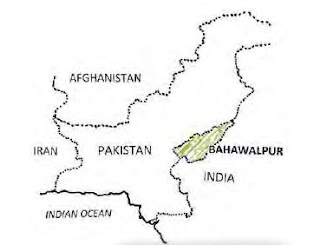I found the following article in the April 2017 edition of "The American Philatelist". Copying it here for my Pakistani friends who have interest in the postage stamps from the State of Bahawalpur.
Bahawalpur
Status: Princely State in South Asia (Pakistan)
Area: 17,494 sq. miles (estimate)
Population: 1,341,209 (1941)
Currency: 100 paisa = 1 Rupee. Rs 1.30= U.S. $1 (1948)
Bahawalpur
Status: Princely State in South Asia (Pakistan)
Area: 17,494 sq. miles (estimate)
Population: 1,341,209 (1941)
Currency: 100 paisa = 1 Rupee. Rs 1.30= U.S. $1 (1948)
 |
| A special stamp issued in 1933 commemorates a century of alliance with Great Britain. |
Bahawalpur was settled in the 18th century by Muslim refugees from the Sindh. It became an independent state in 1802. The amir of Bahawalpur signed a treaty of alliance with the British in 1833 as protection from the expansive Sikh rulers of Lahore. The amir was a loyal ally who supported the British in wars against Afghanistan and the Sikhs. As a reward the amir was allowed to maintain his own army and received an annual stipend from the East India Company. As the site of the only rail bridge over the Sutlej River, Bahawalpur was strategically located.
 |
| The first five Official stamps of 1945 show important irrigation pipes of the Sutlej Valley, animals, and the Juma Masjid Palace, Scott O1 to O5. The stamps were good only for domestic use. |
When the amir died in 1866, the British established a “temporary” administration and set up the postal service. In 1870, responsibility for the post office was assumed by the Imperial Post. The amir pressed the British to allow him to issue his own stamps. Despite his close ties to the British, the amir’s repeated requests were denied. The British considered separate postal services for the princely states inefficient and duplicative.
Hopeful of British approval, or perhaps to force their hand, the amir ordered seven stamps in 1933 from De La Rue in London. One commemorated 100 years of the British Alliance and depicted the British and Bahawalpur flags crossed behind a coat of arms. Six were attractive pictorials. But, again the amir’s request was rejected. Although it is presumed that the stamps were not officially issued, used examples are known.
 |
| Amir Muhammad Bahawal Khan I Abbasi (reign 1746–1749) is on Bahawalpur’s first postage stamp issued in 1947, Scott 1. |
In 1945, the amir finally got the right to issue stamps. As a reward for Bahawalpur’s military support in World War II, an agreement was signed in New Delhi that allowed Bahawalpur to issue stamps for official use within the state. As with other “feudatory states,” letters sent outside the state would require British India postage. Under this authority, the six pictorials from 1933 were released overprinted “service” in Urdu.
On August 14, 1947, Pakistan and India broke apart. All the princely states were released from their treaties with Great Britain with the understanding that they would join either India or Pakistan by October 3. At least in theory, Bahawalpur was independent for about two months. The amir took advantage of this by overprinting 17 current British Indian definitives for local use.
 |
| Three amirs appear on a high denomination 10-rupee Official stamp from a set of eight in 1948, Scott O24. |
Bahawalpur became a part of Pakistan and on December 1, 1947, issued its first stamp under the authority of the Pakistani Post Office. Separate Bahawalpur issues continued until October 10, 1949, after which they were replaced by stamps of Pakistan. Bahawalpur was subsequently divided into three Pakistani provinces.






















1 comment:
I feel happy to have spent my time in reading such a useful blog.....Totosite
Post a Comment